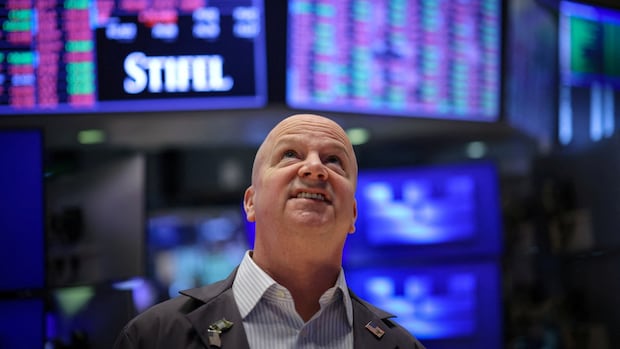Trump's Tariffs: Another Day of Market Chaos
Editor’s Note: Fresh economic data has been released today highlighting the ongoing impact of Trump's tariffs. This article analyzes the latest market fluctuations and their implications.
Why This Matters: The Lingering Shadow of Trump's Tariffs
Trump's trade policies, particularly his imposition of tariffs on various goods, continue to cast a long shadow over global markets. Understanding the ongoing effects is crucial for investors, businesses, and consumers alike. This article delves into the latest market turmoil, exploring the ripple effects of these tariffs and their potential long-term consequences. We will examine specific sectors heavily impacted, analyze the political ramifications, and offer insights into potential future scenarios.
Key Takeaways
| Point | Impact |
|---|---|
| Increased Import Costs | Higher prices for consumers, reduced purchasing power. |
| Retaliatory Tariffs | Damage to US exports and businesses relying on international trade. |
| Supply Chain Disruptions | Increased costs and delays in manufacturing and distribution. |
| Market Volatility | Uncertainty leading to stock market fluctuations and investor anxiety. |
| Inflationary Pressures | Rising prices impacting the overall economy and consumer spending. |
Trump's Tariffs: A Continuing Market Earthquake
The recent release of economic data underscores the continuing instability stemming from Trump's tariffs. While some argue the tariffs protected domestic industries, the evidence points to a more complex and often negative impact on the broader economy. The initial shockwaves have morphed into a persistent tremor, destabilizing markets and creating uncertainty.
Key Aspects of the Ongoing Tariff Impact
- Agricultural Sector: Farmers have been particularly hard hit, facing reduced export opportunities and increased competition.
- Manufacturing: Rising input costs due to tariffs have squeezed profit margins and led to job losses in some sectors.
- Consumer Goods: Higher prices for imported goods have reduced consumer spending power, dampening economic growth.
- Geopolitical Tensions: Retaliatory tariffs have further strained international relations and complicated global trade.
Detailed Analysis: Sector-Specific Impacts
The impact of Trump's tariffs isn't uniform. The agricultural sector, for instance, experienced a sharp decline in exports to China, resulting in significant financial losses for farmers. Manufacturing sectors reliant on imported components saw increased production costs, impacting their competitiveness. Meanwhile, consumers faced higher prices for various goods, ranging from clothing to electronics.
Interactive Elements
The Role of Retaliatory Tariffs
The imposition of tariffs by other countries in response to Trump's policies created a tit-for-tat scenario, further disrupting global trade flows. This retaliatory action damaged US exports and highlighted the interconnected nature of the global economy. The risks associated with such trade wars include reduced economic growth, increased inflation, and strained diplomatic relations. Mitigations could include negotiated trade agreements and a move towards multilateralism. The long-term impact remains a subject of ongoing debate and economic modeling.
Navigating Market Volatility in a Tariff-Affected World
Understanding the nuances of the market's response to Trump's tariffs is crucial for investors. The increased volatility necessitates a more cautious approach, emphasizing diversification and risk management strategies. Further analysis reveals that investors are increasingly seeking haven assets like gold and government bonds during periods of heightened uncertainty. This shift reflects a lack of confidence in the stability of equity markets during ongoing trade disputes.
People Also Ask (NLP-Friendly Answers)
Q1: What is the impact of Trump's tariffs?
A: Trump's tariffs have led to increased import costs, retaliatory tariffs, supply chain disruptions, market volatility, and inflationary pressures, negatively impacting various sectors of the economy.
Q2: Why are Trump's tariffs still relevant today?
A: The long-term effects of Trump's tariffs continue to unfold, impacting businesses, consumers, and international relations. The economic consequences and market instability persist, making it a crucial topic for ongoing discussion.
Q3: How can businesses mitigate the impact of tariffs?
A: Businesses can mitigate the impact through diversification of suppliers, exploring alternative sourcing options, hedging against currency fluctuations, and lobbying for policy changes.
Q4: What are the main challenges with Trump's tariffs?
A: Challenges include unpredictable market fluctuations, retaliatory actions from other countries, negative impacts on specific industries, and the broader strain on global economic stability.
Q5: How can I protect my investments during tariff uncertainty?
A: Diversify your portfolio, invest in less volatile assets, and stay informed about economic developments and policy changes.
Practical Tips for Navigating Tariff Uncertainty
Introduction: These practical tips offer guidance to businesses and investors seeking to navigate the turbulent economic landscape created by Trump's tariffs.
Tips:
- Diversify your supply chains: Reduce reliance on single-source suppliers.
- Explore alternative sourcing options: Identify suppliers in countries unaffected by tariffs.
- Hedge against currency fluctuations: Implement strategies to protect against exchange rate risks.
- Monitor economic indicators: Stay informed about market trends and policy changes.
- Lobby for policy changes: Engage with government representatives to advocate for your interests.
- Invest in risk management strategies: Develop contingency plans to address potential disruptions.
- Consult with financial advisors: Seek professional guidance on investment strategies.
- Focus on building resilient businesses: Adapt your strategies to address market uncertainty.
Summary: These tips can help businesses and investors navigate the economic challenges posed by Trump's tariffs.
Transition: Let's conclude by summarizing the key takeaways and looking ahead.
Summary (Resumen)
Trump's tariffs have created significant market chaos and continue to impact the global economy. The effects are widespread, affecting various sectors and contributing to uncertainty. Understanding these impacts is crucial for navigating the current economic climate.
Closing Message (Mensaje Final)
The lingering effects of Trump's tariffs serve as a reminder of the interconnected nature of the global economy and the potential consequences of protectionist policies. What long-term strategies will be most effective in mitigating these continuing effects?
Call to Action (Llamada a la acción)
Stay informed about the latest economic developments and subscribe to our newsletter for in-depth analysis and expert insights on global markets. Share this article with your network to raise awareness about the ongoing impact of Trump's tariffs.

